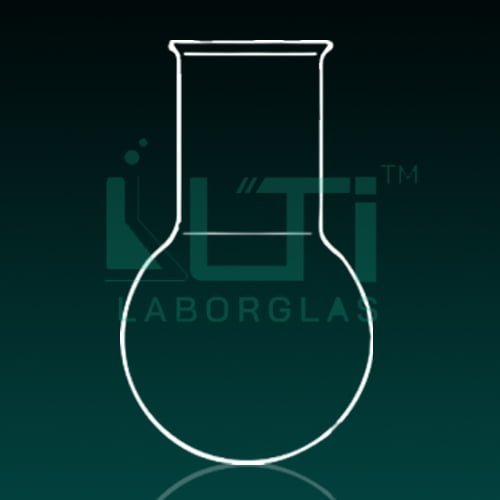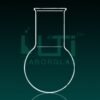- Made from ASTM E-438 Type 1, Boro 3.3 heat resistance glass
- Complies with ISO 24450
- With beaded rim
| PART No. | Capacity (ml) | D. (mm) | D1. (mm) | H. (mm) | PACK Qty. |
| 5570-50 | 50 | 51 | 34 | 95 | 10 |
| 5570-100 | 100 | 64 | 34 | 110 | 10 |
| 5570-250 | 250 | 85 | 50 | 143 | 10 |
| 5570-500 | 500 | 105 | 50 | 168 | 10 |
| 5570-1000 | 1000 | 131 | 50 | 200 | 10 |
| 5570-2000 | 2000 | 166 | 76 | 240 | 6 |
Here are some of its typical uses:
- Heating and Boiling Reactions: The round bottom shape allows for even distribution of heat when placed on a heating mantle or other heating apparatus. This is particularly useful for reactions that involve boiling or require consistent heating.
- Distillation: Round bottom flasks are often used in distillation setups. The wide neck allows for easy attachment of condensers and other glassware components needed for distillation processes.
- Chemical Reactions and Synthesis: The shape of the round bottom flask facilitates efficient mixing and stirring of reaction components. This is important for reactions that require thorough mixing of reactants to ensure a homogeneous reaction mixture.
- Solvent Evaporation: Round bottom flasks are commonly used in rotary evaporators for solvent evaporation. The wide neck allows for easy pouring of the solvent into the flask and efficient removal of the solvent under reduced pressure.
- Fractional Distillation: Similar to regular distillation, round bottom flasks with wide necks are used in fractional distillation setups. Fractional distillation is employed to separate components of a mixture based on their different boiling points.
- Sample Storage: In some cases, these flasks may be used for temporary storage of reaction mixtures or samples.
- Refluxing: The round bottom flask is often employed in reflux setups where the reactants are heated, and the vapor is condensed and returned to the reaction mixture. This is useful for reactions that require prolonged heating.







